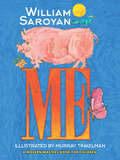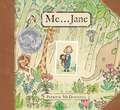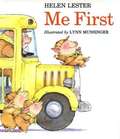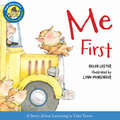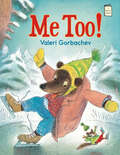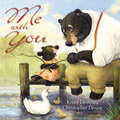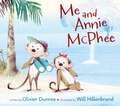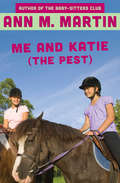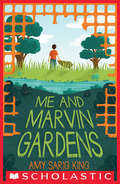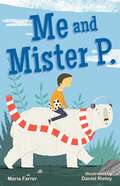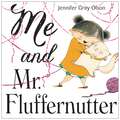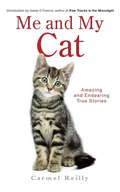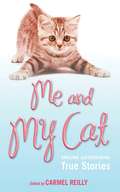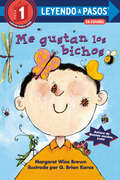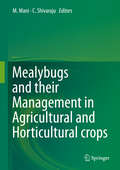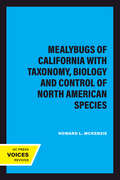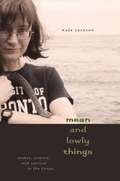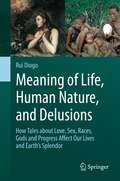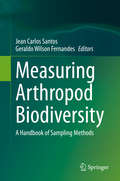- Table View
- List View
Me
by William Saroyan Murray TinkelmanOnce upon a time there was only one word -- me.If you wanted to say here I am, you said -- me.It was the only word anyone ever heard!But only people said me. Dogs said bark, bark, take me to the park; cats said purr, purr, I am the Queen be kind to her; cows said moo, moo, I am a cow, what are you? But slowly, change came, and in his first children's book, Pulitzer Prize-winning dramatist William Saroyan spins a fanciful fable that speculates on how members of the human race actually started talking to each other. Recounted with catchy rhymes and a spirited simplicity, this story is illustrated with lively pictures that glow with the warmth of watercolors. An internationally renowned writer, playwright, and humanitarian, William Saroyan wrote short stories, plays, novels, memoirs, and essays. His tale of Me is illustrated by Murray Tinkelman, whose art has appeared in Atlantic Monthly, The New York Times, The Washington Post, and many other prominent publications. Their charming children's story has been out of print for decades but now returns to circulation in this vibrant new edition.
Me . . . Jane
by Patrick Mcdonnell Emma Walton HamiltonIn his characteristic heartwarming style, Patrick McDonnell tells the story of the young Jane Goodall and her special childhood toy chimpanzee named Jubilee. As the young Jane observes the natural world around her with wonder, she dreams of "a life living with and helping all animals," until one day she finds that her dream has come true. <p><p> One of the world's most inspiring women, Dr. Jane Goodall is a renowned humanitarian, conservationist, animal activist, environmentalist, and United Nations Messenger of Peace. In 1977 she founded the Jane Goodall Institute (JGI), a global nonprofit organization that empowers people to make a difference for all living things.With anecdotes taken directly from Jane Goodall's autobiography, McDonnell makes this very true story accessible for the very young--and young at heart.<P> <i>Advisory: Bookshare has learned that this book offers only partial accessibility. We have kept it in the collection because it is useful for some of our members. To explore further access options with us, please contact us through the Book Quality link on the right sidebar. Benetech is actively working on projects to improve accessibility issues such as these.<P></i> <b>There is a scanned version of this book available at: https://www.bookshare.org/browse/book/527103/ While there are no images, there are image descriptions. </b>
Me First
by Helen Lester Lynn MunsingerPinkerton Pig always has to be first -- first to eat, first off the bus -- until, running to be first for a sandwich, he finds himself in trouble with the Sand Witch.
Me First (Read-aloud)
by Helen Lester Lynn Munsinger"This funny, fetching tale will bring chuckles--and a lesson--to any child with a tendency to echo Pinkerton's cries of 'Me first.'" -Publishers Weekly Pinkerton Pig will do anything to be first--first down the slide, first in line at the trough-a-teria, first on the bus. His pushy ploys backfire on a Pig Scouts hike when he hears the magic words "Would you care for a sandwich?" Little does he know, he's being tricked by a sandcastle-dwelling Sandwitch in need of care! How long will Pinkerton be doomed to powder her warty nose? This cheery look at the dangers of piggishness is now part of a fun hardcover series about life lessons. This ebook includes audio narration as well as a code for free downloadable audio.
Me Tarzan
by Betsy ByarsNobody knew Dorothy could do such a tremendous Tarzan yell. Not Dwayne, Dorothy's enemy, who wants the part of Tarzan in the class play more than she does. Not Mr. Mooney, their teacher, who has no choice but to give Dorothy the part. Not Dorothy's parents, who are as uneasy as Mr. Mooney about it. Not even Dorothy! But when the uncontrollable urge comes over her--the smell of the jungle, the sense of raw, primitive emotions, the wildness--Dorothy lets out a Tarzan yell so loud, so effective, they all feel its incredible power. And so do the neighborhood animals. More and more animals gather whenever Dorothy practices. Then the circus comes to town, and a puma escapes to Dorothy's yard after one of her yells. What will happen on the night of the play--which also happens to be the opening night of the circus-when Dorothy is determined to give the yell of her life? Betsy Byars's lighthearted story is as exuberant and surprising as Dorothy's Tarzan yell.
Me Too! (I Like to Read)
by Valeri GorbachevChipmunk and Bear share a snowy adventure in this easy-to-read Level C book. "I love snow!" says Bear. "Me too!" says Chipmunk. Despite their differences in size, Chipmunk and Bear have a lot in common. When Bear decides to go play in the snow, Chipmunk is eager to tag along. The two friends have fun skiing, skating, and building a snowman—although Chipmunk needs a hand now and then in the deep snow! This simple tale of friendship is perfect for early readers, with simple, highly repetitive text and four or less sentences per spread. Valeri Gorbachev's charming art adds detail and helps support understanding of the story—and readers are sure to smile at the furry friends' wintery adventures. For more Bear and Chipmunk, don't miss Valeri Gorbachev's Not Me! The award-winning I Like to Read® series focuses on guided reading levels A through G, based upon Fountas and Pinnell standards. Acclaimed author-illustrators--including winners of Caldecott, Theodor Seuss Geisel, and Coretta Scott King honors—create original, high quality illustrations that support comprehension of simple text and are fun for kids to read with parents, teachers, or on their own! For readers who've mastered basic sight words, Level C books feature slightly longer sentences and a wider range of high-frequency words than Level B books. Level C books are suitable for mid-to-late kindergarten readers. When Level C is mastered, follow up with Level D
Me Too, Iguana
by Jacquelyn ReinachThe residents of Sweet Pickles try to help Iguana who wants to be like everyone else she sees.
Me With You
by Kristy DempseyWe're a pair beyond compare,a rare and special two,in all the ways that I am meand you're completely you. From tea time to game time, singing or swinging, in the good times and even the grumpy ones, a granddaughter knows her grandpa is always wonderfully himself, and she is wonderfully herself, and together they are unbeatable! A pair beyond compare, a rare and special two!With simple rhymes and delightfully charming illustrations, Me with You is the perfect book to remind young readers how unique they and their grandparents truly are.
Me and Annie McPhee
by Olivier DunreaA cumulative counting book and rollicking read-aloud, full of fun for readers who love This Is the House that Jack Built and There Was an Old Lady Who Swallowed a FlyIn the middle of the sea,as far as the eye could see,there was nothing to see but sea.Nothing but sea and one tiny island just big enough for me.Just big enough for me and Annie McPhee,who was no bigger than me.But what begins as an empty island in the middle of the sea becomes fuller and fuller as readers turn through the pages. Meet two wee dogs who think that they're frogs, three perky pigs that are all wearing wigs, four frumpy hens who are hunched with their pens -- and more! The lonely island "just big enough for me and Annie McPhee" might not be so lonely after all!Praise for Me and Annie McPhee:"It&’s light, cheery fun, full of verbal and visual silliness."--Publishers Weekly"A bouncy rhythm—and full-on shouted conclusion—can't be beat."--Kirkus Reviews "Preschoolers and kindergartners will delight in this two-in-one cumulative counting tale that&’s just right for reading aloud."--School Library Journal
Me and Katie (the Pest)
by Ann M. MartinWendy&’s little sister is good at everything—especially being annoyingKatie is always good at whatever she tries and everyone adores her. Everyone except Wendy, that is. Just once, ten-year-old Wendy wishes she could outshine her little sister. When she gets a chance to take horseback riding lessons, she plans to prove to her family that she is the best at something.But it&’s not long before Katie decides to steal Wendy&’s thunder by taking riding lessons herself. Soon, the two sisters are in competition again, and this time Wendy is not going to let her sister win. Can the two overcome their rivalry and become friends—or is being first more important?This ebook features an illustrated personal history of Ann M. Martin, including rare images from the author&’s collection.
Me and Marvin Gardens (Fountas & Pinnell LLI Blue)
by Amy Sarig King<p>Obe Devlin has problems. His family's farmland has been taken over by developers. His best friend Tommy abandoned him for the development kids. And he keeps getting nosebleeds, because of that thing he doesn't like to talk about. So Obe hangs out at the creek by his house, in the last wild patch left, picking up litter and looking for animal tracks. <p>One day, he sees a creature that looks kind of like a large dog, or maybe a small boar. And as he watches it, he realizes it eats plastic. Only plastic. Water bottles, shopping bags... No one has ever seen a creature like this before, because there's never been a creature like this before. The animal--Marvin Gardens--soon becomes Obe's best friend and biggest secret. But to keep him safe from the developers and Tommy and his friends, Obe must make a decision that might change everything. <p>In her most personal novel yet, Printz Honor Award winner Amy Sarig King tells the story of a friendship that could actually save the world.</p>
Me and Mister P.: Me And Mister P. , Book Two (Me and Mister P. #2)
by Maria Farrer Daniel RieleyMister P. is the coolest friend a kid could wish for!Arthur is fed up with his younger brother Liam getting all the attention from their parents just because he's a little bit different from other kids. Arthur just wants a normal family and a normal life, where he can play soccer and hang out with friends -- without Liam always being so embarrassing. Just when Arthur can't take it anymore, Mister P. -- a polar bear with a suitcase -- shows up. He doesn't talk, and Arthur is scared of him at first. (He is a polar bear, after all!) But he isn't dangerous. In fact, Mister P. is lots of fun, and even gets along with Liam. He comes with Arthur to school and soccer, and makes life an adventure! Still, Mister P. can't stay forever. But before he goes, he helps as only a polar bear can... leading Arthur to see his brother in a whole new way.
Me and Mr. Fluffernutter
by Jennifer Gray OlsonFrom the creator of Ninja Bunny comes a new story about a little girl and her beloved cat, who learn that friendship is the best compromise of all. A little girl and her cat, Mr. Fluffernutter, are best friends. They do everything together, all the time. But what happens when Mia wants to have a tea party, and play dress-up, and go for a swim? And when Mr. Fluffernutter prefers to stare at the fish bowl? And stare at the fish bowl some more. . . . Can these two be so different—and still be best friends? Here are two new characters to fall in love with—and a celebration of differences, compromise, and friendship. Praise for Ninja Bunny: &“Sweetly humorous fun.&” —Publishers Weekly &“Gorgeous illustrations add a level of humor and whimsy. . . . Ninja Bunny is sure to delight young warriors of all stripes.&” —New York Journal of Books &“Marvelous simplicity.&” —Examiner.com &“Funny and full of motion.&” —Kirkus Reviews
Me and My Cat: Amazing And Endearing True Stories
by Carmel Reilly Denis John O'ConnorEvery cat owner believes that his or her cat understands every word that they say. Every cat owner believes that cats are far more intelligent than dogs - they're just too cool to show it. Every cat owner believes that their cat should be on TV starring in advertisements for everything from furniture and carpets to central heating and, yes, cat food. And those Andrex puppies have had it their own way for far too long...Every cat owner, in fact, is a cat lover. If they're not cat lovers when the cat first comes along - you don't purchase a cat, they choose to live with you - then they will be within a very short space of time. There are stories, of course, that every cat owner loves to tell. It may be that the cat became hugely and unusually distressed the day a relative died unexpectedly on the other side of town. It may be about how the cat is a constant source of comfort during bad times, or how the cat faces up to urban foxes in the garden. It may simply be a story about how the cat is a loving companion.Cat lovers simply love telling cat stories!
Me and My Cat: Amazing And Endearing True Stories
by Carmel ReillyEvery cat owner believes that his or her cat understands every word that they say. Every cat owner believes that cats are far more intelligent than dogs - they're just too cool to show it. Every cat owner believes that their cat should be on TV starring in advertisements for everything from furniture and carpets to central heating and, yes, cat food. And those Andrex puppies have had it their own way for far too long...Every cat owner, in fact, is a cat lover. If they're not cat lovers when the cat first comes along - you don't purchase a cat, they choose to live with you - then they will be within a very short space of time. There are stories, of course, that every cat owner loves to tell. It may be that the cat became hugely and unusually distressed the day a relative died unexpectedly on the other side of town. It may be about how the cat is a constant source of comfort during bad times, or how the cat faces up to urban foxes in the garden. It may simply be a story about how the cat is a loving companion.Cat lovers simply love telling cat stories!
Me and My Cat: Amazing and Endearing True Stories
by Carmel ReillyEvery cat owner believes that his or her cat understands them. Every cat owner believes that cats are far more intelligent than dogs--they're just too cool to show it. Every cat owner believes that their cat should be starring in TV commercials. Every cat owner, in short, is a cat lover. If you're not a cat lover when the cat first comes along--you don't purchase a cat, they choose to live with you--then you will be within a very short space of time. There are stories, of course, that every cat owner loves to tell. It may be how the cat comforted them on the day a relative died unexpectedly. It may be about how the cat stares down urban foxes in the garden. It may be a story of the cat's escapades, or how it got stuck up a tree. It may simply be a story about how the cat is a loving companion. From editor Carmel Reilly--author of numerous collections of inspirational stories including True Tales of Angel Encounters--comes this delightful anthology of tales about beloved cats and the joy they bring to human lives. Each story is a different cat owner's tribute to his or her favorite feline, and each falls into a special category, from Cats with Attitude to Kitten Escapades, from Magical Cats to tales about Cats' Nine Lives. You'll read about cats that ward off unwanted visitors, cats that hoard silver jewelry, and cats that get stuck in tubs of yogurt. Accompanied by twenty-five charming illustrations and told with warmth, humor, and affection, Me and My Cat is an ideal gift for the cat lover in your life, and a perfect book to curl up with next to a furry friend.
Me and My Dragon (Me and My Dragon)
by David BiedrzyckiWho wouldn't want a pet dragon? See what raising a friendly dragon might look like in this hilarious read aloud about a boy and his pet. While dragons may not be the most traditional of pets we come to learn how, Sparky, would be the perfect pet and pal. From helpful tips on how to pick a dragon, what to do when your dragon misbehaves, and what NOT to feed them (broccoli). Clever and wry text paired with bright and comedic illustrations will make Me and My Dragon a storytime favorite for kids and adults alike.
Me and My Puppy (Me and My Pets)
by Anne Yvonne GilbertUsing highly detailed and realistic illustrations, these books are designed to show the younger child exactly what owning a pet means. The simple text describes the animal's behaviour, shows how to handle the pet properly, and the general care that each animal needs.
Me encantaría tener un cachorro (¡Arriba la Lectura!, Level Q #31)
by Sharon Parsons¿Te gustaría cuidar un cachorro? Es una gran responsabilidad. Tendrás que aprender a entrenarlo desde su primer año de vida. Aquí encontrarás consejos para el cuidado de los cachorros. ¡Y también verás por qué un perro puede llegar a ser tu mejor amigo! NIMAC-sourced textbook
Me gustan los bichos (LEYENDO A PASOS (Step into Reading))
by Margaret Wise Brown¡Los bichos son cool en esta edición en español del álbum ilustrado escrito por la autora bestseller de Buenas noches, luna! Bichos negros. Bichos verdes. Bichos gordos. Bichos de todos. ¡Me gustan los bichos! Elige tu favorito en esta edición en español del libro infantil de Margaret Wise Brown acerca de nuestros amigos pequeños. LEYENDO A PASOS es una línea de Step into Reading que ofrece ediciones en español de libros nivelados. Los libros Paso 1 tienen letra grande y palabras fáciles. Son ideales para niños que conocen el abecedario y que quieren comenzar a leer. Su ritmo, rima y pistas visuales contribuyen a la comprensión del texto. Bugs are cool in this Spanish edition of the Step 1 early reader written by the bestelling author of Goodnight Moon! Black Bugs. Green Bugs. Fat Bugs. Buggy Bugs. I like bugs! Pick your favorite one in this Spanish edition of Margaret Wise Brown's book about our tiny friends.Step 1 Readers feature big type and easy words for children who know the alphabet and are eager to begin reading. Rhyme and rhythmic text paired with picture clues help children decode the story. LEYENDO A PASOS is a Spanish-language line of Step into Reading.
Mealybugs and their Management in Agricultural and Horticultural crops
by M. Mani C. ShivarajuThis book is a compilation of information on all basic aspects of mealybugs, as well as management strategies for mealybug species affecting different crop plants in different countries. It highlights the latest information on morphology, cytogenetics, taxonomy, molecular characterization, biology, damage, ecology, natural enemies, ant association, control measures, insecticide resistance and pheromones - essential aspects which will equip researchers to pursue further research on mealybugs. The book examines current trends in the management of mealybugs for a variety of agricultural and horticultural crops, forest plants and mulberry in different countries, while also addressing the negative effects of chemical control methods and presenting success stories of mealybug control that utilize their natural enemies. It offers a valuable guide for crop growers, government officials and other stakeholders in the industry, as well as researchers and students engaged in related research and development activities.
Mealybugs of California with Taxonomy, Biology and Control of North American Species
by Howard L. McKenzieThis title is part of UC Press's Voices Revived program, which commemorates University of California Press’s mission to seek out and cultivate the brightest minds and give them voice, reach, and impact. Drawing on a backlist dating to 1893, Voices Revived makes high-quality, peer-reviewed scholarship accessible once again using print-on-demand technology. This title was originally published in 1967.This title is part of UC Press's Voices Revived program, which commemorates University of California Press’s mission to seek out and cultivate the brightest minds and give them voice, reach, and impact. Drawing on a backlist dating to 1893, Voices Revived</DIV
Mean and Lowly Things: Snakes, Science, and Survival in the Congo
by Kate JacksonIn 2005 Kate Jackson ventured into the remote swamp forests of the northern Congo to collect reptiles and amphibians. Her camping equipment was rudimentary, her knowledge of Congolese customs even more so. She knew how to string a net and set a pitfall trap, but she never imagined the physical and cultural difficulties that awaited her. Culled from the mud-spattered pages of her journals, Mean and Lowly Things reads like a fast-paced adventure story. It is Jackson’s unvarnished account of her research on the front lines of the global biodiversity crisis—coping with interminable delays in obtaining permits, learning to outrun advancing army ants, subsisting on a diet of Spam and manioc, and ultimately falling in love with the strangely beautiful flooded forest. The reptile fauna of the Republic of Congo was all but undescribed, and Jackson’s mission was to carry out the most basic study of the amphibians and reptiles of the swamp forest: to create a simple list of the species that exist there—a crucial first step toward efforts to protect them. When the snakes evaded her carefully set traps, Jackson enlisted people from the villages to bring her specimens. She trained her guide to tag frogs and skinks and to fix them in formalin. As her expensive camera rusted and her Western soap melted, Jackson learned what it took to swim with the snakes—and that there’s a right way and a wrong way to get a baby cobra out of a bottle.
Meaning of Life, Human Nature, and Delusions: How Tales about Love, Sex, Races, Gods and Progress Affect Our Lives and Earth's Splendor
by Rui DiogoWhatever are your beliefs, background, education, political views or interests, one thing is sure: this book will engage you, teach you something new, and more importantly make you to re-think deeply about critical aspects of your daily-life, including sex, love, food, physical activities, diseases, work and stress, and how you see and deal with other people, other animals, and the planet in general. Indeed, it focuses on topics that have fascinated people from all places and historical periods since times immemorial: Why are we here? What is the meaning of life? Are we progressing, and will we thrive? It does this by integrating in a unique fashion information from ancient Greek, Sumerian, Hindu, Jewish, Buddhist, Christian and Muslim texts to high-tech brain research, facts about near-death experiences, Covid-19, QAnon conspiracies, virtual reality and dating aps; from Adam and Eve to the rise of misogyny and racism to Black Lives Matter, Me-Too, Hollywood romantic movies and Disney fairy-tales. Contrary to notions about 'human progress' and 'Homo Deus' defended by authors such as Harari, Pinker and Dawkins, it shows that human history instead involves the repetition of similar imaginary tales created by a combination of traits found in other animals and the uniquely human obsession about 'cosmic purpose' stories related to our awareness of death's inevitability. Organized religions appeared later, chiefly during the rise of agriculture and 'civilizations'. Diogo navigates mesmerizing untold stories revealing a paradox: these events and the industrial 'revolution' increased inequality, oppression, slavery, subjugation of women, famines, plagues, 'work', stress, and suicides. Data from psychology, biology, neurobiology, and cross-cultural studies of hunter-gatherers and so-called 'developed' societies reveal an even more profound paradox: within all forms of life, the 'sapient being' is the one immersed in Neverland's world of unreality - truly a Homo irrationalis, fictus and socialis believing in fictional tales about cosmic 'duties', 'romantic meant to be', demons, inferior 'races' and 'genders', conspiracies, and 'justified' slavery, warfare, genocides, and animal abuses. Importantly, such tales play, on the other hand, crucial functions such as help coping with death and a plethora of societal troubles, decreasing stress, or preventing drug and alcohol abuse. An optimist and passionate wondered and wanderer, Diogo provides enthralling details about the history of religion, discrimination, romantic love, warfare, diseases and Earth's biodiversity illustrating how 'virtue is in the middle' and that we - with our intriguing combination of beliefs, bodily needs and desires, artistic abilities, and mismatches between our senses' illusions and the cosmos' reality - are not 'better' or 'worse' than the other millions of captivating living species. This powerful and urgently needed message has critical repercussions for how we understand, care about, and mindfully enjoy living in this splendid planet, in the reality of here and now.Pre-publication comments: "I applaud the enormous work that Diogo has invested in this follow-up to his widely acclaimed Evolution driven by organismal behavior book, and the challenge of getting people to think beyond and outside of our usual set of definitions and expectations. The case-studies provided in the book are fascinating and insightful" (Drew Noden, Award-winning Emeritus Professor, Cornell University)"Rui Diogo is becoming the Slavoj Zizek of evolutionary biology" (Marcelo Sanchez-Villagra, Director of the Paleontological Institute and Museum of the University of Zurich)
Measuring Arthropod Biodiversity: A Handbook of Sampling Methods
by Geraldo Wilson Fernandes Jean Carlos SantosThis book brings together a wide range of sampling methods for investigating different arthropod groups. Each chapter is organised to describe and evaluate the main sampling methods (field methods, materials and supplies, sampling protocols, effort needed, and limitations); in addition, some chapters describe the specimen preparation and conservation, species identification, data collection and management (treatment, statistical analysis, interpretation), and ecological/conservation implications of arthropod communities. The book aims to be a reference for zoologists, entomologists, arachnologists, ecologists, students, researchers, and for those interested in arthropod science and biodiversity. We hope the book will contribute to advance knowledge on field assessments and conservation strategies. Arthropods represent the most speciose group of organisms on Earth, with a remarkable number of species and interactions still to be described. These invertebrates are recognized for playing key ecological roles in terrestrial, freshwater and marine ecosystems. Because of the increasing and relentless threats arthropods are facing lately due to a multitude of human induced drivers, this book represents an important contribution to assess their biodiversity and role in ecosystem functioning and generation of ecosystem services worldwide.
